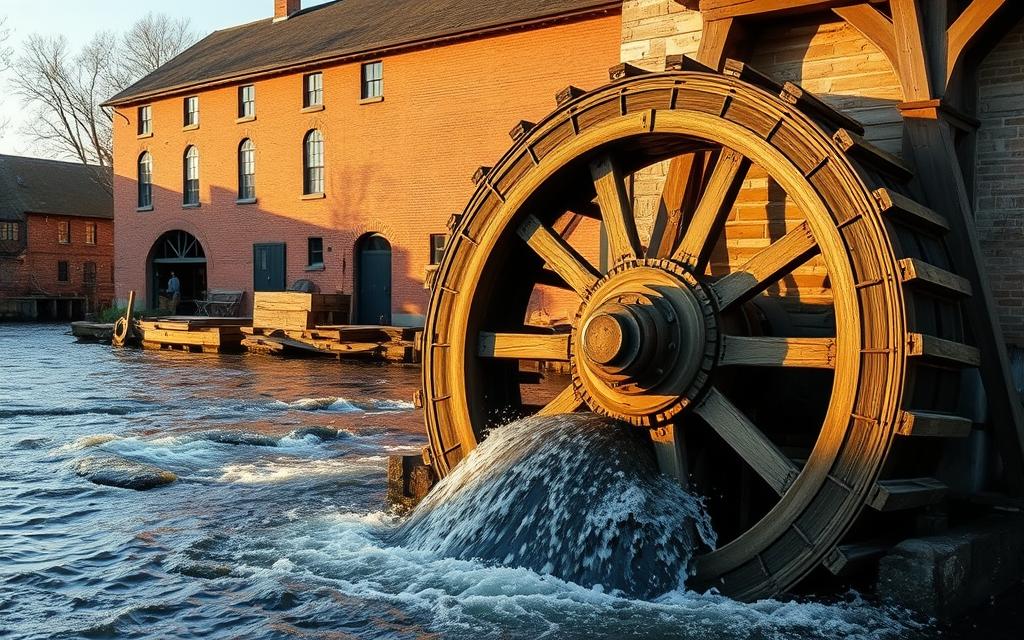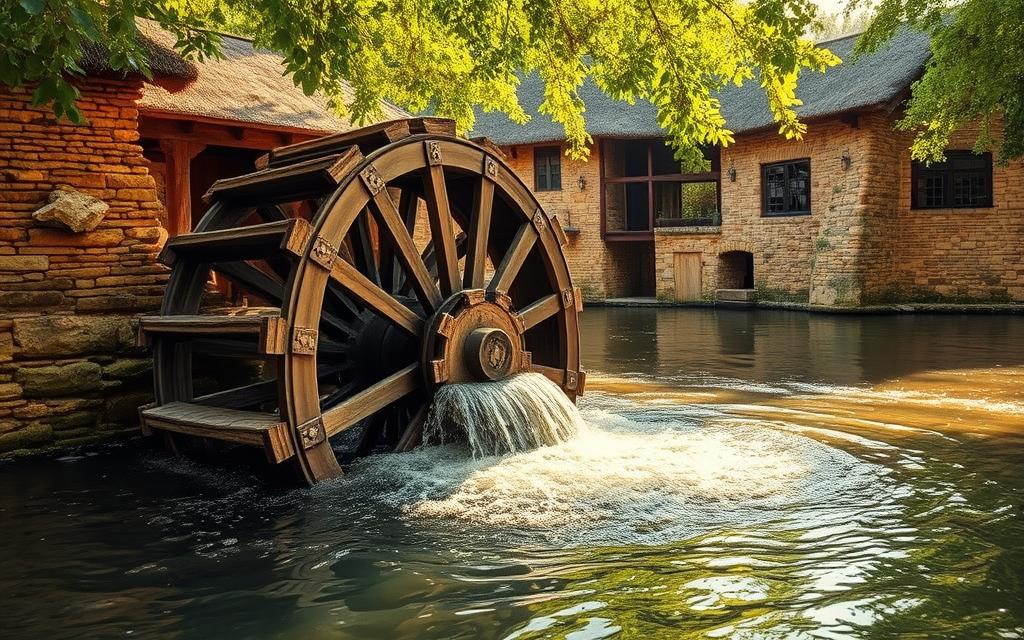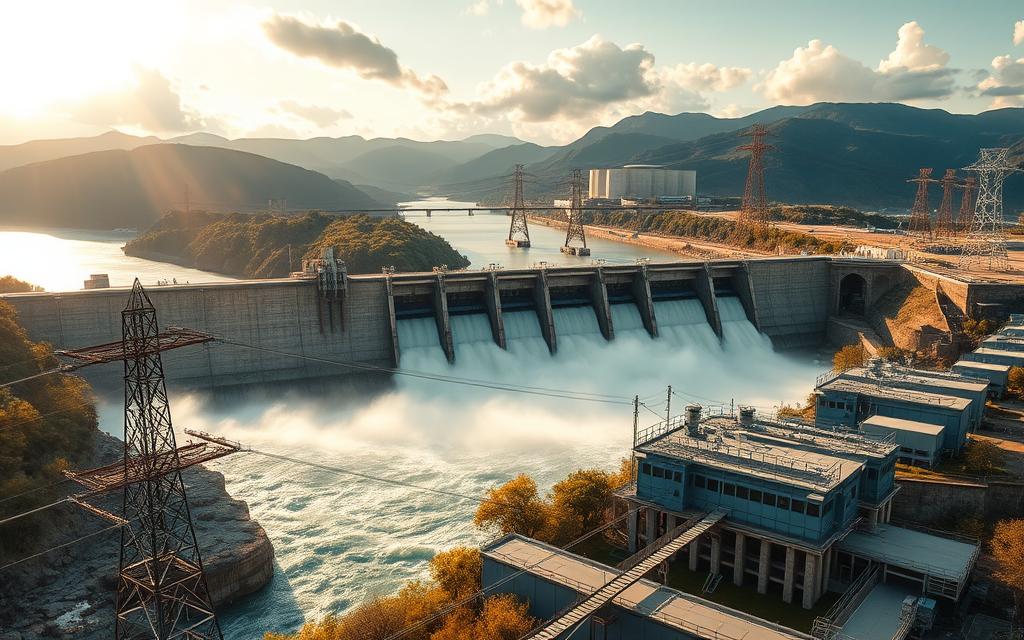For centuries, water wheels have been a cornerstone of industrial power, harnessing the energy of flowing water to drive machinery. The use of wheels and wheel-based systems allowed for the mechanization of various processes, from grinding grain to sawing wood, revolutionizing industry across civilizations.
The evolution of water power saw mills become a ubiquitous feature of industrial landscapes, particularly in areas with significant river flow. However, as the century progressed, new power sources emerged, challenging the dominance of traditional river-powered mills.
This shift marked a significant turning point in the history of industrial energy production, as technology advanced and new methods of generating power became more prevalent.
The Rise of River-Powered Mills
As one of the earliest forms of renewable energy, river-powered mills played a crucial role in the evolution of industrial processes. The water wheel, a fundamental component of these mills, first appeared in the ancient Near East, specifically in ancient Egypt, during the 4th century BC.
The earliest known water wheels were likely used for irrigation purposes before evolving into devices capable of grinding grain and performing other mechanical tasks. This marked a significant shift from manual labor to mechanized processes, revolutionizing early industrial practices.
Ancient Origins of Watermill Technology
The history of watermill technology is a testament to human ingenuity. Archaeological evidence indicates that water wheel usage was present in West Asia during the 4th century BC. By the 3rd century BC, the water wheel was being utilized in the Near East for moving millstones and small-scale grain grinding.
| Region | Period | Usage |
|---|---|---|
| Ancient Egypt | 4th century BC | Irrigation and grain grinding |
| Mesopotamia | 3rd century BC | Moving millstones |
| Syria and Asia Minor | 2nd century BC | Vertical watermill development |
The development of water wheel technology spread gradually from the Near East to other civilizations. Each culture adapted and improved the basic design to suit local conditions and specific needs, demonstrating the versatility and potential of water power.
The transition from simple water-lifting devices to mechanical power generators represented a crucial technological leap. This period of early water wheel development laid the groundwork for more sophisticated designs that would emerge in later centuries.
By understanding the history and evolution of water-powered mills, we can appreciate the significant role they played in shaping early industrial processes and the broader course of human development.
How Water Wheels Transformed Early Civilizations
The advent of water wheels marked a significant turning point in the development of early civilizations. By harnessing the power of water, ancient societies were able to mechanize various industrial processes, significantly boosting productivity. This innovation had far-reaching impacts on the economic and social structures of these civilizations.
Greek engineers made crucial advancements in water wheel technology, particularly in the development of toothed gearing systems. The Greek engineer Philo of Byzantium (ca.280−220 BC) wrote the earliest known description of water-driven wheels in his technical treatises. Historical research shows that the horizontal-wheeled mill originated from the Greek colony of Byzantium in the first half of the 3rd century BC.
Greek and Roman Engineering Innovations
The Romans improved upon Greek designs, creating more efficient water wheels that could be deployed throughout their vast empire for industrial purposes. Vitruvius wrote the first detailed technical description of a watermill around 40/10 BC, featuring an undershot wheel that transmitted power through an advanced gearing mechanism. By the 1st century AD, Roman engineers had significantly improved upon Greek designs.
Roman water wheels utilized both undershot designs, where water flows beneath the wheel, and overshot configurations, where water flows from above. Each type was optimized for specific environmental conditions and power requirements. The spread of water wheel technology throughout the Roman Empire established a complex network of water-powered mills that supported urban centers and military operations.
| Characteristics | Undershot Water Wheels | Overshot Water Wheels |
|---|---|---|
| Water Flow | Water flows beneath the wheel | Water flows from above |
| Efficiency | Less efficient, dependent on river flow | More efficient, can be gravity-fed |
| Environmental Suitability | Suitable for rivers with strong currents | Suitable for areas with significant elevation changes |
The impact of water wheels on early civilizations was profound, enabling the development of more sophisticated industrial processes and transforming the way societies functioned. As water wheel technology continued to evolve, it played a crucial role in shaping the course of human history.
The Mechanics Behind Water Power
At the heart of water-powered mills lies an intricate system of mechanics that harnesses the energy of flowing water. The fundamental principle behind water power is the conversion of kinetic energy from flowing water into rotational force, which can then be used for mechanical work through a system of gears and shafts.
The water wheel, a crucial component of this system, comes in two basic designs: a horizontal wheel with a vertical axle, and a vertical wheel with a horizontal axle. The latter can be further subdivided based on where the water hits the wheel, including backshot, overshot, breastshot, undershot, and stream-wheels. Each design has its specific application depending on the environmental conditions.
Understanding Different Watermill Types
Different types of watermills were optimized for specific conditions. For instance, overshot wheels were used where there was a significant height difference, typically more than a couple of meters, making them suitable for locations with high head and low flow. In contrast, undershot wheels were ideal for locations with high flow but minimal elevation change.
The efficiency of water wheels varied significantly between designs. Overshot wheels achieved efficiencies of up to 80-90%, while early undershot wheels had efficiencies of only 20-30%. This variation in efficiency highlights the impact of engineering refinements on power output.
Water wheel installations often included sophisticated water management systems, such as millponds, which served as energy reservoirs. These allowed operators to store water until needed, maintaining consistent power output despite variable river flow.
In summary, the mechanics behind water power involve a complex interplay of kinetic energy conversion, wheel design, and water management. Understanding these elements is crucial to appreciating the historical significance and operational efficiency of water-powered mills.
The Golden Age of Water Mills
The Domesday Book, commissioned by William the Conqueror in 1085, offers remarkable insights into the prevalence of watermills in medieval England. This detailed survey revealed approximately 6,000 operational watermills across the country, making up over 99% of all known mills from before the end of the 11th century.
A closer examination of the data shows that at least 5,624 watermills existed during this period, with the Great Domesday alone listing more than 5,000. The numbers indicate a significant presence of watermills, with roughly one mill for every two settlements in England. This demonstrates how deeply watermills had become integrated into the fabric of medieval English society.

Medieval Expansion Across European Rivers
The survey also highlighted varying patterns of ownership across different regions. Some mills were owned by multiple individuals, with areas like Norfolk featuring extensive shared ownership arrangements. For instance, Norfolk had 87 manors with shared mills, while Lincoln had 38, Wiltshire 23, and Suffolk 15. This shared ownership suggests collaborative resource management among local communities.
The number of watermills continued to grow rapidly after the Domesday survey. Historical records indicate that the number of English watermills doubled over the next two centuries, reaching an estimated 10,000 to 12,000 by the late 13th century. This growth was driven by the rising population and a more sophisticated economy.
| Region | Number of Manors with Shared Mills |
|---|---|
| Norfolk | 87 |
| Lincoln | 38 |
| Wiltshire | 23 |
| Suffolk | 15 |
The proliferation of water wheels across European rivers transformed them into productive economic corridors. Water wheels became so prevalent that they fundamentally altered riparian ecosystems and water flow patterns, creating a human-managed hydraulic system that supported expanding agricultural and proto-industrial activities.
The golden age of water mills represented a period when human civilization achieved unprecedented integration with natural water systems, harnessing rivers as the primary energy source for economic development across the European continent.
Industrial Applications of Water Mills
The versatility of water wheels enabled their widespread adoption across different industries, revolutionizing manufacturing processes. As the industrial revolution gained momentum, the role of water mills expanded significantly beyond their traditional use in grain processing.
Early watermills had focused primarily on milling grain, but their industrial uses expanded rapidly during the 18th and 19th centuries. Richard Arkwright’s water frame, powered by waterwheels, became vital in mechanizing textile production. Water-powered trip hammers and blast furnace bellows reshaped metal manufacturing, enabling the production of larger quantities of higher quality metals than previously possible with manual methods.
Beyond Grain: Diverse Uses of Water Power
Waterpower mechanized manual processes in the textile industry, such as fulling—the cleaning and thickening of cloth. Production moved from urban centers to rural waterways, which deepened the commitment of these towns at the expense of cities. Watermills powered various industrial activities, including sawmills and timber processing, metal forging and industrial hammers, tanning of hides, vegetable oil pressing, and rock crushing for mining operations.
The development of power transmission systems using belts, shafts, and gears allowed a single water wheel to drive multiple machines simultaneously, creating the first true factories centered around water power. This innovation was crucial in the industrial revolution, as it enabled complex manufacturing processes in a single facility.
- Water power revolutionized textile production through innovations like Richard Arkwright’s water frame, which mechanized spinning and dramatically increased output while reducing labor requirements.
- The versatility of water wheels as power sources led to their adaptation for increasingly specialized industrial processes, demonstrating their remarkable flexibility as the primary industrial power technology before steam.
- Water-powered sawmills dramatically increased timber processing capabilities, while specialized applications emerged for tanning hides, pressing oils, fulling cloth, and crushing ore for mining operations.
As industries continued to evolve, the role of water mills adapted, showcasing their significance in the development of industrial manufacturing. The use of water power marked a significant step in the transition from manual labor to mechanized production, laying the groundwork for future industrial advancements.
The Economic Impact of Water-Powered Mills
Water-powered mills had a profound impact on the economic landscape of pre-industrial Europe, changing the dynamics of production and employment. These mills were not just simple machinery; they represented significant investments that transformed local economies.
The construction of a water wheel and its associated infrastructure required substantial capital, making mill ownership a source of wealth and social power. Feudal lords, who often built and owned these mills, established monopolies that generated steady revenue streams through mandatory fees charged to local farmers for grain processing.
The efficiency brought about by water wheels dramatically reduced labor requirements for tasks like grain grinding. One miller could now accomplish work that previously required many laborers, fundamentally altering traditional employment patterns.
Creating Local Economies Around Rivers
Water-powered mills facilitated the development of specialized production areas along rivers, turning waterways into the economic backbones of pre-industrial communities. Industries relocated from urban centers to rural locations with suitable water power, reshaping settlement patterns over time.
- The concentration of production and employment along rivers transformed local economies, making waterways crucial for pre-industrial communities.
- Mill ownership became a significant source of wealth and social power due to the substantial investment required for construction.
- Feudal lords established monopolies over grain processing, creating steady revenue streams through mandatory fees.
- The efficiency of water wheels reduced labor requirements, altering traditional employment patterns.
- Industries relocated to rural areas with water power resources, reshaping settlement patterns.
- The economic advantages of water wheel technology helped create broader regional and national markets.
As historian Marc Bloch noted, the spread of watermills across Europe was facilitated by the political landscape, with areas of divided authority building more watermills. This phenomenon underscores the complex interplay between technological innovation and socio-political factors in shaping economic development.
Technological Improvements in Waterwheel Design
John Smeaton’s pioneering work in the mid-18th century laid the groundwork for modern waterwheel technology. His systematic approach to designing waterwheels involved rigorous experimentation, leading to significant enhancements in their efficiency and performance. This marked a crucial turning point in the history of water-powered mills, as it transitioned the construction of waterwheels from an art to a science.
The application of scientific principles to waterwheel design led to a deeper understanding of how factors such as wheel shape, size, bucket design, and water flow velocity affected power output. Smeaton’s research demonstrated that overshot wheels were approximately 2.5 times more efficient than undershot designs, a finding that guided the implementation and optimization of waterwheels across various industrial settings.
John Smeaton’s Scientific Approach
Smeaton’s work revolutionized water wheel technology by applying scientific principles to design. He conducted systematic experiments that dramatically improved efficiency and established engineering standards for water wheel construction. His research showed that the efficiency of waterwheels could be significantly enhanced by optimizing their design according to the site conditions.
Engineers developed increasingly specialized water wheel designs optimized for specific conditions. For instance, overshot wheels were best suited for locations with high water heads, while breastshot wheels offered moderate efficiency for sites with moderate water flow. In contrast, undershot wheels, although the least powerful, were simple to construct and suitable for locations with high flow but minimal elevation change.
- The scientific approach led to sophisticated understanding of water wheel mechanics, transforming construction from an art to a science.
- Smeaton’s findings on overshot and undershot wheels guided optimizations across industrial settings.
- Specialized designs were developed for specific site conditions, enhancing overall efficiency.
These innovations in waterwheel design not only improved the capabilities of watermills but also laid the foundation for later hydropower technologies, including reaction turbines and impulse turbines. By the 19th century, waterwheels had become highly efficient, with the best overshot designs achieving 80-90% efficiency in converting water’s potential energy into mechanical force.
The Industrial Revolution: A Turning Point
As the Industrial Revolution took hold, water wheels became increasingly sophisticated, playing a crucial role in early manufacturing processes. The need for more efficient power systems drove innovations in water wheel technology, transforming the way goods were produced and distributed.

The Industrial Revolution marked a significant turning point in the history of water wheel technology. Traditional designs were systematically improved to meet the increasing power demands of emerging industrial processes. Water power served as the initial driving force behind the Industrial Revolution, with early factories strategically positioned along rivers to harness water wheel energy for mechanized production systems.
From Craft Production to Industrial Manufacturing
The transition from craft production to industrial manufacturing was enabled by water wheels that could power multiple machines simultaneously through complex power transmission systems of gears, belts, and shafts. This marked a significant shift in production methods, allowing for the concentration of workers and machinery in a single location.
- Water wheels facilitated the development of the factory system by providing consistent, centralized power.
- The limitations of water power, including geographic constraints and seasonal variations in flow, ultimately created bottlenecks that would drive the search for alternative power sources.
- Despite these limitations, water wheel technology continued to evolve, with engineers pushing the boundaries of efficiency and scale.
The evolution of water wheel technology during the Industrial Revolution was characterized by significant improvements in design and functionality. As the demands of industrial processes grew, so did the need for more efficient and powerful water wheels. This led to innovations in materials and construction techniques, further enhancing the role of water power in early industrial manufacturing.
By examining the impact of the Industrial Revolution on water wheel technology, it becomes clear that this period was crucial for the development of modern manufacturing systems. The legacy of water wheel technology can still be seen in contemporary industrial practices, highlighting the importance of understanding historical innovations in the context of modern advancements.
What Technology Spelled the End of River-Powered Mills?
The dominance of waterpower in the early Industrial Revolution was challenged by the emergence of a more versatile energy source. As industrial demands grew, the limitations of relying on river-powered mills became increasingly apparent. The need for a more flexible and reliable power source led to the adoption of a new technology that would eventually supplant waterpower.
The rise of steam power marked a significant turning point in the history of industrial energy production. Steam engines, developed by inventors like James Watt, offered unprecedented power density and efficiency, allowing factories to operate independently of rivers and seasonal water flow variations. This technological advancement enabled industrial expansion into previously unsuitable areas and centralized production in urban centers.
The Rise of Steam Power
Steam power emerged as the primary technology that spelled the end of river-powered mills. The development of increasingly efficient steam engines provided industrial operations with the power needed to drive machinery without the constraints of water flow. Steam technology allowed factories to be located anywhere with access to fuel, rather than being restricted to riverside locations.
Despite the rise of steam, water wheels demonstrated remarkable resilience, still providing two-thirds of British grain milling power as late as 1870. However, regional variations in the transition from water to steam power were significant. Areas like Greater Manchester adopted steam earlier due to limited water resources and increasing industrial demands, while other regions maintained water power longer.
The competition between water wheels and steam engines wasn’t always straightforward. Many facilities operated hybrid systems where steam engines worked alongside water wheels or even recirculated water to maintain hydropower operations during dry periods. This adaptability highlights the gradual nature of technological transitions in the industrial sector.
| Technology | Advantages | Limitations |
|---|---|---|
| Water Wheels | Reliable power source in areas with abundant water resources | Limited by seasonal water flow variations and geographic location |
| Steam Engines | Flexible and reliable, allowing operation away from rivers | Dependent on fuel supply, potentially more expensive to operate |
The transition from waterpower to steam power was a complex process that occurred over several decades. As steam technology continued to improve, it eventually became the dominant form of energy production in many industrial sectors. The legacy of water wheels can still be seen in the many historic mills that remain today, a testament to the ingenuity of earlier industrialists.
The Advent of Electricity and Its Impact
The introduction of electricity marked a significant turning point in the history of power generation. As industries began to adopt electrical power, the traditional reliance on water wheels and river-powered mills started to decline.
The early 20th century saw a gradual shift towards electricity, with local entrepreneurs establishing small-scale hydroelectric plants. These plants often utilized existing mill sites, converting them to generate electricity for nearby communities. For instance, in 1905, electricity was being generated in Manorhamilton, and by 1933, Paul Jeiter had set up a system in Dromahair.
Early Electrical Generation Systems
Early electrical generation systems created an evolutionary bridge between traditional water power and modern electrical systems. They often used water wheels and turbines to drive generators, thus maintaining the utility of water resources while transitioning to a more versatile form of energy.
The ability to transmit electricity over long distances via power lines was a game-changer. It eliminated the need for factories to be located directly adjacent to power sources, fundamentally changing industrial geography and urban development patterns.

The transition to centralized electricity generation and distribution networks gradually displaced local power systems. National utilities, such as Ireland’s Electricity Supply Board (ESB), acquired independent operators between the 1930s and 1960s, consolidating the industry.
| Year | Event | Location |
|---|---|---|
| 1905 | Electricity generation begins | Manorhamilton |
| 1927 | ESB established | Ireland |
| 1933 | Paul Jeiter’s hydroelectric system | Dromahair |
The versatility, reliability, and scalability of electricity provided compelling advantages over direct mechanical water power. It allowed for smaller, more efficient motors to be placed exactly where power was needed, rather than requiring complex mechanical transmission systems.
The Final Decline of Traditional Watermills
The advent of new technologies in the early 20th century sealed the fate of traditional watermills. As centralized electrical power generation and distribution networks expanded, they offered more reliable and cost-effective energy than individual water wheels could provide.
The final decline of traditional watermills accelerated as large-scale hydroelectric projects demonstrated the superior efficiency of modern turbine technology. For instance, Ireland’s 85-megawatt Ardnacrusha plant, completed in 1929, showcased the potential of modern hydroelectric power, hastening the obsolescence of traditional water wheels.
Centralization of Power Generation
National electrification programs prioritized standardized power delivery, gradually absorbing or displacing local water-powered electrical systems. Economic factors played a crucial role in this decline, as maintaining aging water wheel infrastructure became more costly than purchasing electricity from the expanding grid.
- The expansion of centralized electrical power generation and distribution networks made traditional watermills less competitive.
- Large-scale hydroelectric projects like Ardnacrusha demonstrated the efficiency of modern turbine technology.
- Economic considerations, including maintenance costs, further contributed to the decline of watermills.
Despite the overall trend toward centralization, some remote rural mills continued commercial operations well into the 20th century. The technological obsolescence of water wheels as direct power sources coincided with broader social and economic changes, including rural depopulation and the consolidation of agricultural processing.
Regional Variations in Watermill Decline
The story of watermill decline is one of regional variation, shaped by local conditions and needs. Different regions adapted to new technologies at different rates, influenced by factors such as environmental conditions, economic specialization, and cultural practices.
In areas like Greater Manchester, the heart of British cotton production, waterpower resources became limited by 1838 due to increased factory mechanization and crowded waterways. A drier 19th-century climate further exacerbated the challenges faced by watermills in this region.
European Transitions
Across Europe, the decline of watermills followed distinct timelines. Environmental factors significantly influenced regional transition patterns, with areas experiencing drier climate conditions facing greater pressure to adopt alternative power sources.
- The decline of water wheels was influenced by regional factors, including resource limitations and increasing demand.
- Economic specialization affected transition timing, with industries like textile manufacturing adopting steam and electricity earlier.
- Cultural and social factors also played a role, with some areas maintaining traditional water-powered operations longer.
The characteristics of river basins created natural variations in water wheel viability. Some watersheds maintained abundant water power resources well into the late 19th century, while others faced earlier constraints.
| Region | Timeline for Decline | Influencing Factors |
|---|---|---|
| Greater Manchester | By 1838 | Limited waterpower resources, increased factory mechanization |
| Other British counties | Late 19th century | Abundant waterpower resources, slower adoption of new technologies |
| European regions with drier climates | Varied | Environmental factors, economic specialization |

The uneven pattern of water wheel decline across different places and time periods demonstrates how technological transitions rarely occur uniformly. Instead, they follow complex pathways shaped by local conditions and needs.
Case Studies: Notable Water Mills and Their Fate
The Barbegal complex, built in the 2nd century CE, represents one of the most impressive examples of water wheel technology in ancient times. Located near Arles in southern France, this remarkable facility was a testament to Roman engineering and industrial capabilities.
The Barbegal watermill complex is considered “the greatest known concentration of mechanical power in the ancient world.” It featured 16 overshot waterwheels arranged in two parallel rows down a hillside, capable of producing approximately 25 metric tons of flour daily. This output was sufficient to feed about 27,000 people, demonstrating the extraordinary scale that water wheel technology could achieve.
The Barbegal Complex: Rome’s Industrial Marvel
The sophisticated engineering of the Barbegal complex included carefully designed water channels, precisely constructed mill buildings, and an integrated production system that maximized efficiency through its hillside arrangement. The complex was built near Arelate (modern Arles) in southern France and showcased Roman industrial genius.
- The Barbegal complex featured 16 overshot waterwheels in two parallel rows, cascading down a hillside, showcasing advanced water wheel technology.
- This Roman industrial site could produce about 25 metric tons of flour daily, enough to feed 27,000 people, highlighting the scale of water wheel installations.
- Archaeologists consider Barbegal “the greatest known concentration of mechanical power in the ancient world,” with no comparable facilities in Roman or Asian civilizations.
- The complex’s sophisticated design included water channels and mill buildings that maximized efficiency, demonstrating the engineering capabilities of Roman water wheel designers.
The eventual abandonment of the Barbegal site illustrates how even the most advanced water wheel installations became obsolete as economic conditions, political structures, and technologies evolved. Modern archaeological work has revealed new details about the site’s construction and operation, providing insights into Roman engineering.
Modern Hydroelectric Power: The Evolution of Water Energy
Modern hydroelectric power represents a significant milestone in the technological advancement of water energy, building upon the principles of traditional water wheels. The journey from ancient watermills to contemporary hydroelectric dams is a testament to human innovation and the quest for more efficient energy production.
The development of modern hydroelectric power was made possible by the introduction of more efficient turbine systems. Benoît Fourneyron’s groundbreaking turbine design in 1827 marked the beginning of a new era in water energy harnessing. His design offered greater efficiency, smaller size, and lower cost compared to conventional water wheels.
From Water Wheels to Turbines
The transition from traditional water wheels to turbines was a crucial step in the evolution of hydroelectric power. Turbines are capable of handling high heads, or elevations, that exceed the capability of practical-sized water wheels. This advancement has enabled the construction of modern hydroelectric dams, which can be viewed as the descendants of the water wheel, as they too take advantage of the movement of water downhill.
The key benefits of modern hydroelectric power include:
- Increased efficiency in energy production
- Ability to handle high water elevations
- Optimization of designs for specific site conditions through reaction and impulse turbines
- Scalability and flexibility in energy generation
The evolution from direct mechanical power transmission via water wheel shafts to electrical generation through turbine-driven generators has solved the geographic limitations that had constrained traditional water power applications. Modern hydroelectric dams apply the same basic principle of capturing energy from falling water but at scales and efficiencies that would have been unimaginable to early mill operators.
| Technology | Efficiency | Scalability |
|---|---|---|
| Traditional Water Wheels | Low to Moderate | Limited |
| Modern Turbines | High | High |
| Hydroelectric Dams | Very High | Very High |

In conclusion, modern hydroelectric power is the result of centuries of innovation and technological advancement in harnessing water energy. From the early water wheels to the sophisticated turbine systems of today, the industry has come a long way, offering a cleaner, more efficient source of energy for the future.
The Revival of Small-Scale Hydropower
The revival of small-scale hydropower represents a significant shift towards sustainable energy sources, combining historical technology with modern engineering principles. This resurgence is driven by the need for renewable energy and the potential for local, resilient power generation.
Restoration projects have played a crucial role in this revival, breathing new life into abandoned mill sites. These projects not only preserve industrial heritage but also generate clean electricity through refurbished water wheels or modern turbines installed in historical settings.
Restoration Projects and Heritage Preservation
Heritage preservation efforts have documented and restored significant water wheel sites, such as the impressive seven-story mill building with its large overshot wheel and extensive millrace system. The restoration of these sites highlights the importance of preserving our industrial heritage while embracing modern sustainable energy solutions.
- Modern small-scale hydropower installations often incorporate sophisticated electronic controls and grid-connection capabilities.
- Environmental concerns have sparked interest in “run-of-river” hydropower systems that capture energy without the environmental impacts of large dams.
- The economic viability of small-scale hydropower has improved with technological advances and policy incentives for renewable energy.
| Aspect | Traditional Watermills | Modern Small-Scale Hydropower |
|---|---|---|
| Technology | Water wheels, mechanical systems | Modern turbines, electronic controls |
| Energy Output | Limited, mechanical power | Significant, electricity generation |
| Environmental Impact | Minimal, run-of-river | Low, with proper design |
The combination of historical technology and modern engineering principles in small-scale hydropower represents a significant step towards sustainable energy. As restoration projects continue and new installations are developed, the potential for clean, local energy generation grows.
Conclusion: The Technological Evolution of Power Generation
As we reflect on the history of power generation, the evolution of water wheels stands out as a testament to human innovation. For nearly two millennia, water wheels served as humanity’s primary industrial power source, demonstrating remarkable longevity as a core technology.
The principles first developed for harnessing water flow through wheels continue to influence modern hydroelectric engineering. Contemporary turbine designs represent refined applications of concepts understood by mill operators centuries ago. The decline of traditional water wheels resulted from a convergence of technological innovations, primarily steam power and electricity.
Despite their eventual obsolescence, water mills left an indelible mark on human development, enabling agricultural processing, early manufacturing, and mechanical innovations. Today’s renewed interest in small-scale hydropower and the preservation of historic mill sites reflects appreciation for this technological heritage. The fundamental principles of water power remain relevant in an age seeking sustainable energy alternatives, continuing into the 21st century.







